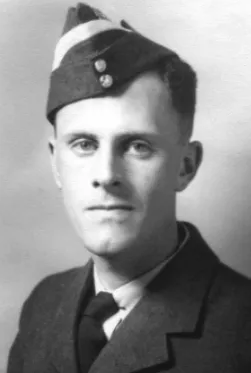Fiddes, John Duncan
Killed in Action 1944-04-25


Birth Date: 1918-May-07
Born: British Columbia, Canada
Son of Robert and Laura Ethel (nee Johnstone) Fiddes of Hollyburn,
Home: Vancouver, British Columbia
Enlistment: Vancouver, British Columbia
Enlistment Date: 1941-05-29
Service
RCAF
Unit
166 (B) Sqn- Squadron (RAF)
Tenacity
Base
RAF Kirmington
Rank
Warrant Officer
Position
Warrant Officer
Service Numbers
R/106742
Target
 Karlsruhe Germany
Karlsruhe Germany
First Burial
 Communal Cemetery, Avesnes-Sur-Helpe, Nord, France
Communal Cemetery, Avesnes-Sur-Helpe, Nord, France
Warrant Officer John Duncan Fiddes had previously been employed by the Royal Bank of Canada from April 22, 1937, first at the Vancouver, British Columbia Hastings and Homer branch and later the Vancouver Davie Street branch from where he enlisted in the RCAF May 29, 1941
Lancaster Mk.I/III LM529
Bombing Karlsruhe Germany 1944-April-24 to 1944-April-25
166 (B) Sqn (RAF) RAF Kirmington
166 Squadron (Tenacity), RAF Kirmington. Lancaster BIII aircraft LM 529 AS-I was shot down by night fighter pilot Oberleutnant Friedrich Thorl of Stab 1/NjG4. The Lancaster exploded and crashed near Wallers-Trelon (Nord) 20 km South-East of Avesnes-sur-Helpe, France during an operation against targets in Karlsruhe, Germany
The entire crew were lost
Warrant Officer John Duncan Fiddes (RCAF), Flight Sergeant Joseph Walter Edgar (RCAF), Sergeant Benjamin Cohen (RAFVR), Sergeant Harry Harbon (RAFVR), Sergeant Leonard Kirkham (RAFVR), Pilot Officer David Reid Tait (RAFVR) and Sergeant John Templeton (RAFVR) were all killed in action
Nachtjagd Combat Archive 1944 Part 2 16 March - 11 May by Theo Boiten, page 87
 Royal Air Force Serial and Image Database
Royal Air Force Serial and Image Database
Lancaster LM529
Avro Lancaster

Canadian Warplane Heritage Museum
The Avro Lancaster is a British Second World War heavy bomber. It was designed and manufactured by Avro as a contemporary of the Handley Page Halifax, both bombers having been developed to the same specification, as well as the Short Stirling, all three aircraft being four-engined heavy bombers adopted by the Royal Air Force (RAF) during the same wartime era.
The Lancaster has its origins in the twin-engine Avro Manchester which had been developed during the late 1930s in response to the Air Ministry Specification P.13/36 for a capable medium bomber for "world-wide use". Originally developed as an evolution of the Manchester (which had proved troublesome in service and was retired in 1942), the Lancaster was designed by Roy Chadwick and powered by four Rolls-Royce Merlins and in one version, Bristol Hercules engines. It first saw service with RAF Bomber Command in 1942 and as the strategic bombing offensive over Europe gathered momentum, it was the main aircraft for the night-time bombing campaigns that followed. As increasing numbers of the type were produced, it became the principal heavy bomber used by the RAF, the Royal Canadian Air Force (RCAF) and squadrons from other Commonwealth and European countries serving within the RAF, overshadowing the Halifax and Stirling. Wikipedia
166 (B) Sqn Tenacity (Huddersfield's Own)
No 166 Squadron RAF was originally formed at Bircham Newton, Norfolk on June 13, 1918, designed as a heavy bomber unit, to fly the Handley Page V/1500 aircraft. The squadron was never fully mobilized because the Armistice intervened. The squadron was re-formed in November 1936 as a heavy bomber unit, flying Handley Page Heyfords, later equipping with Armstrong Whitworth Whitleys. It was based at Boscombe Down, Wiltshire from November 1936 to January 1937, when it moved to Leconfield, Yorkshire. The squadron became part of an air observer's school on June 7, 1938, and then became a 1 Group pool squadron in May 1939. From September 1939 it was based at Abingdon, Berkshire until April 1940. In that month the squadron merged with no. 97 Squadron to form No. 10 OTU.
In January 1943 the squadron was re-formed at Kirmington, Yorkshire (53.578,-0.344, now Humberside Airport), from flights of Nos. 150 and 170 squadrons, when parts of these squadrons were posted to the Middle East. It was again bomber squadron, flying Vickers Wellingtons in No. 1 Group of Bomber Command. It remained at Kirmington until the end of WWII, later re-equipping with Avro Lancasters. In the period 27/28 January 1943 and 25 April 1945, it dropped 27,287 tons of bombs and laid 333 tons of mines. The squadron won "at least" 2 DSOs, 2 CGMs, 117 DFCs and 108 DFMs in the course of WWII. The squadron was disbanded on November 18, 1945.
 Canadian Virtual War Memorial
Canadian Virtual War Memorial Commonwealth War Graves Commission
Commonwealth War Graves Commission Findagrave.com
Findagrave.com



 Lancaster Bomber
Lancaster Bomber Wikipedia
Wikipedia